Tropical and Temperate Cyclones
In this article we will study about Tropical and Temperate cyclones.
Tropical Cyclones
Origin and Properties of Tropical cyclones
Tropical cyclones originate and intensify over warm oceans in tropical areas.
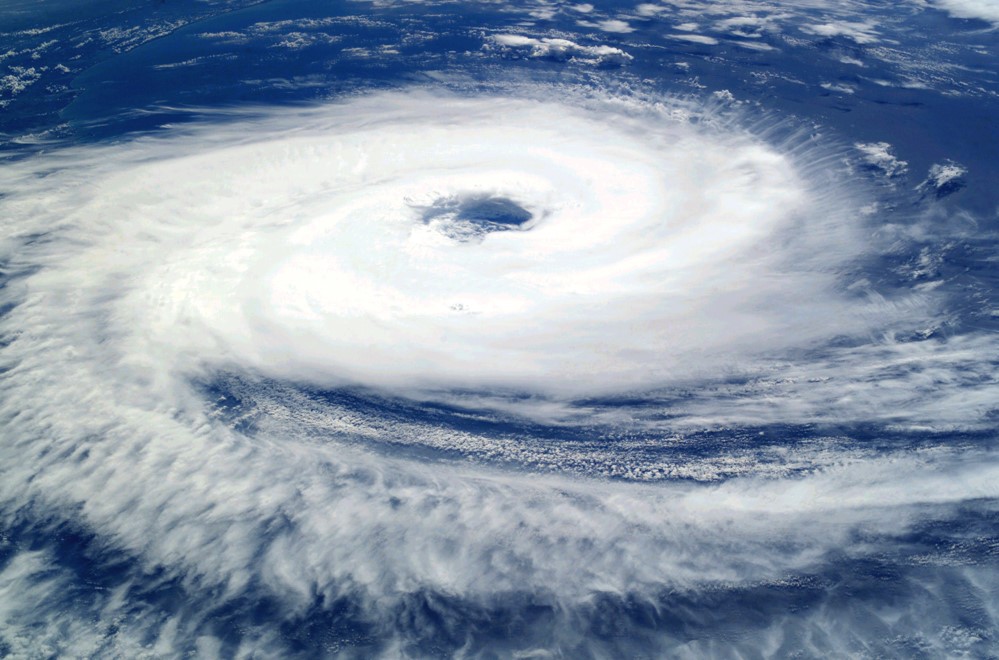
They cause violent winds and very heavy rainfall.
The storm system moves slowly (around 300 - 500 km per day).
On hitting the coastal areas, they bring about large scale destruction.
 Note
NoteLandfall of the cyclone - The place where a tropical cyclone crosses the coast.
 Different names of Cyclones
Different names of CyclonesTropical cyclones are known by different names in different areas of the world:
Cyclones - in Indian Ocean
Hurricanes - in the Atlantic
Typhoons - in Western Pacific and South China Sea
Willy-willies - in Western Australia
Favourable conditions for tropical storms
Here are the conditions that are favourable in the formation (as well as intensification) of tropical storms:
Ocean water temperature higher than 27° C.
Presence of the Coriolis force.
A pre-existing weak low-pressure area.
Sources of the energy that intensify the storm are:
condensation process in the cumulonimbus clouds (around the eye of the storm).
continuous supply of moisture from the sea.
How the tropical cyclone dissipates?
On reaching the land, a tropical cyclone dissipates and dies its natural death, as the moisture supply is cut off.
Structure of Tropical cyclones
Here’s a diagram of the vertical structure of a mature tropical cyclonic storm:
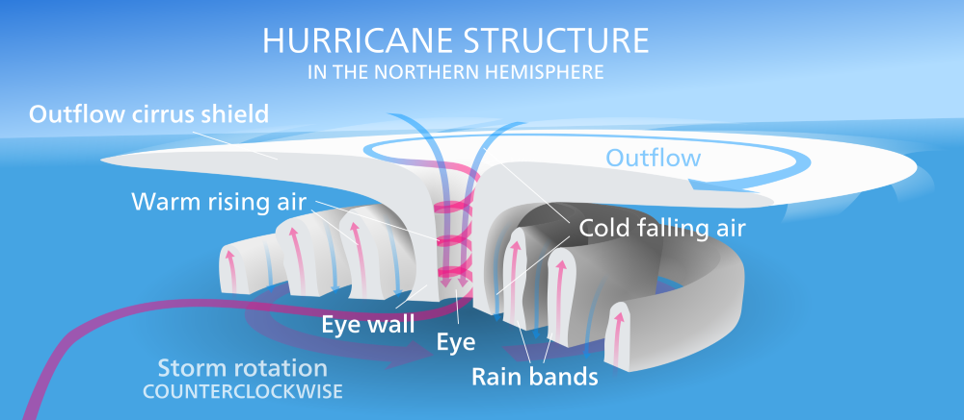
Tropical cyclones have a huge diameter (between 150 and 250 km).
Eye of tropical cyclone – the centre of the storm.
This region is calm because of the subsiding air.Region around the eye
There’s a strong spirally circulating wind around the eye. It has the following features:
- Strong spiraling ascent of air, reaching even to the tropopause.
- Maximum velocity winds (as high as 250 km per hour)
- Torrential rain occurs here.
Difference between Cyclone and Anti-cyclone
- Cyclonic circulation - it is the wind circulation around a low pressure area.
- Anti-cyclonic circulation - it is the wind circulation around a high pressure area.
Cyclones and Anti-cyclones involve both horizontal and vertical wind movement.
The direction of horizontal winds around such systems changes according to their location in different hemispheres:

As far as vertical wind movement is concerned:
- Winds move up at the center of a cyclone.
- Winds move down at the center of an anti-cyclone.
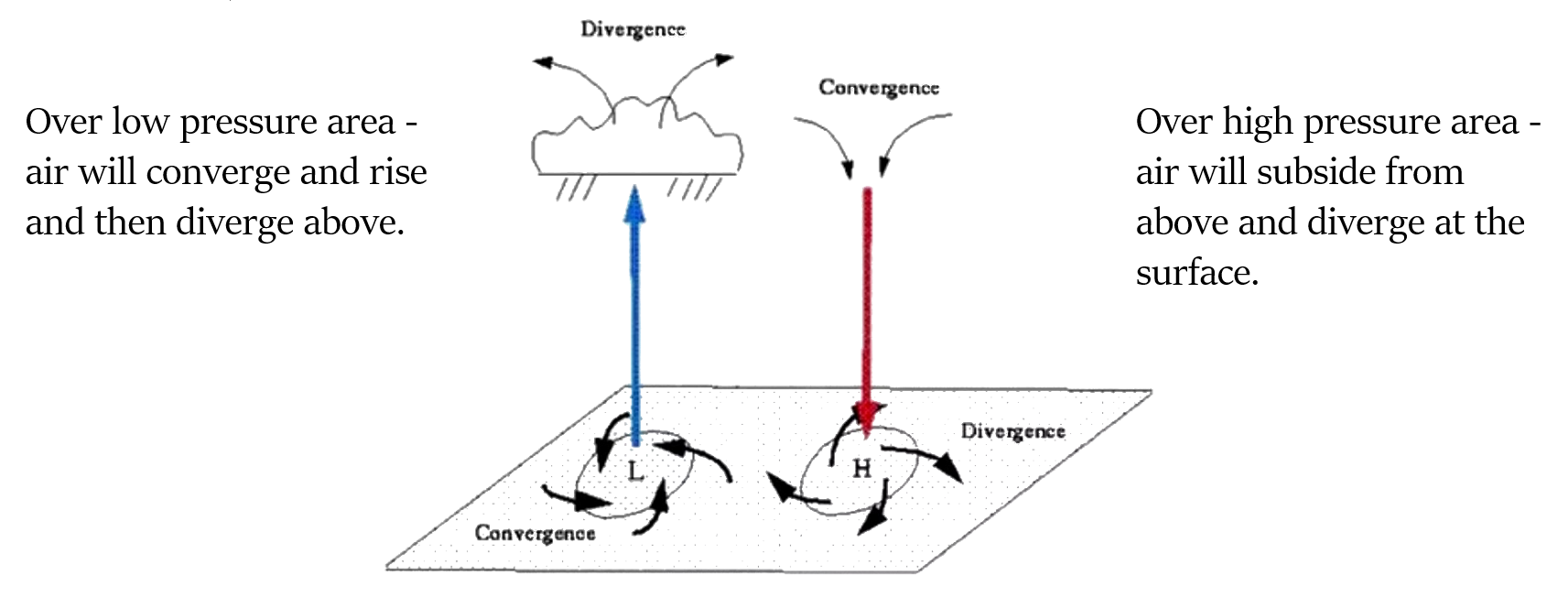
 Note
NoteOther factors (apart from cyclones and anti-cyclones) that may lead to vertical movement of air:
- Eddies
- Convection currents
- Orographic uplift
- Uplift along fronts
Temperate Cyclones
Temperate cyclones are also known as Extra Tropical Cyclones and Mid-latitude Cyclones.
Before we study these Temperate or Extra Tropical Cyclones, we should know about Air Masses & Fronts.
Air Masses
Airmass - a large body of air having only a little horizontal variation in temperature and moisture.
When the air remains over a homogenous area (ocean or plains) for a long period of time, it acquires the distinctive characteristics (temperature, humidity, etc.) of the area.
Classification of air masses
We classify air masses as per the source regions.
 Note
NoteSource regions - These are the homogenous surfaces over which air masses form.
Five major source regions and airmasses:
 Tropical air masses are warm and polar air masses are cold.
Tropical air masses are warm and polar air masses are cold.
Fronts
Front - the boundary zone when two different air masses meet.
The fronts occur in middle latitudes.
Frontogenesis - The process of formation of fronts.
Characteristics of fronts:
- steep gradient in temperature and pressure.
- they cause the air to rise. It leads to formation of clouds and then precipitation.
Classification of fronts
There are four types of fronts: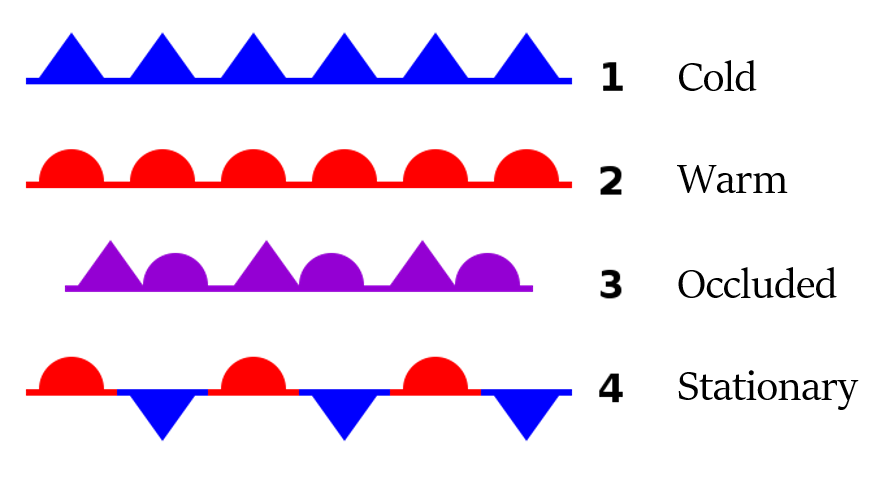
Cold Front
Cold front – The contact zone that is formed when the cold air moves towards the warm air mass.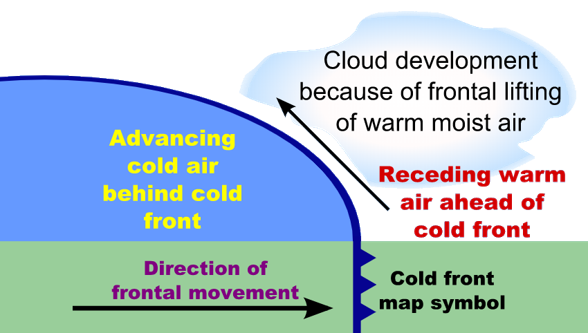
Warm Front
Warm front - The contact zone that is formed when the warm air mass moves towards the cold air mass.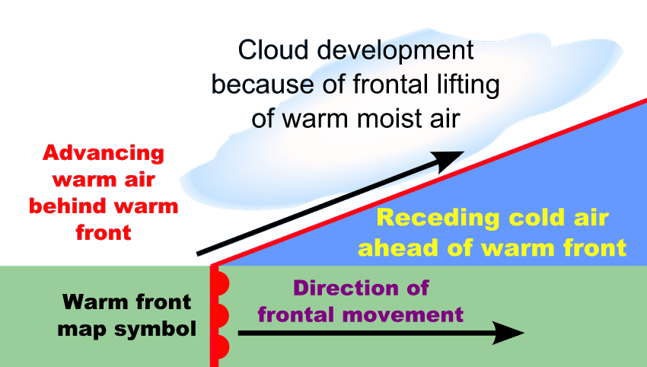
Occluded front
Occluded front - If an air mass is fully lifted above the land surface.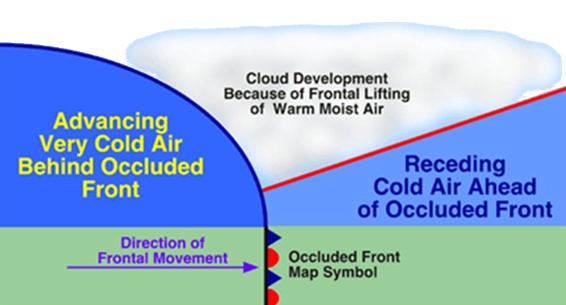
Apart from these three, there is also a Stationary Front.
Now, let us come back to our main topic of Temperate or Extra Tropical Cyclones.
Temperate/Extra-Tropical Cyclones
Middle latitude or extra tropical cyclones - The systems developing in the mid and high latitude, beyond the tropics.
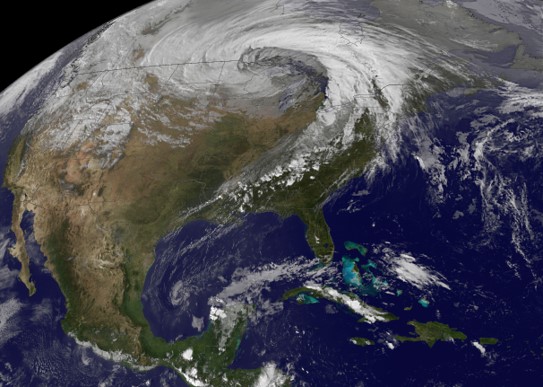
Formation of these cyclones occur along the polar front.
Process of formation of Temperate Cyclones
In the northern hemisphere, we have these pre-existing conditions:
- warm air blows from the south of the front
- cold air blows from the north of the front.
It sets in motion an anticlockwise cyclonic circulation. It leads to a well developed extra tropical cyclone, with a warm front and a cold front.
The sequence of events is as follows:
Event 1: The warm air glides over the cold air.
It leads to the formation of clouds ahead of the warm front and causes precipitation.Event 2: The cold front approaches the warm air from behind and pushes the warm air up.
It leads to the formation of cumulus clouds along the cold front.Event 3: The cold front moves faster than the warm front and overtakes it. The warm air is completely lifted up and occluded front is formed. It leads to the dissipation of cyclone.
Tropical Cyclones Vs. Temperate Cyclones
Differences between temperate/extra-tropical cyclone and tropical cyclone:
The temperate cyclones have a clear frontal system (not present in the tropical cyclones).
Temperate cyclones can originate over both land and sea. While tropical cyclones originate only over the seas. On landfall, they lose energy and dissipate.
A temperate cyclone affects a much larger area (as compared to a tropical cyclone).
Tropical cyclones are more destructive, as the wind velocity is much higher.
The temperate cyclones move from west to east. On the other hand, tropical cyclones move from east to west.
Other Local Storms
Local storms (e.g. thunderstorms and tornadoes) are small-scale violent storms that last only for a short duration.
Thunderstorms
What is a thunderstorm?
Thunderstorm is a well-grown cumulonimbus cloud. It produces thunder and lightning.
Cause: Intense convection on moist hot days. Rising warm air creates bigger clouds and thereafter causes precipitation.
 Hailstorm
HailstormWhen ice falls down to earth, instead of liquid water rain. It happens when the clouds extend to heights where sub-zero temperature prevails.
Some other phenomenon generated by thunderstorms
Apart from rain or hail, thunderstorms may give rise to some other natural phenomenon too.
Duststorms: If there is insufficient moisture, a thunderstorm can generate duststorms.
Tornado: Sometimes spiralling wind descends from thunderstorms (looking like a trunk of an elephant). These have very low pressure at the centre, that sucks anything that comes in its way (so it causes massive destruction). Tornadoes generally occur in middle latitudes.
 Water spout
Water spoutIt is a tornado over the sea.
